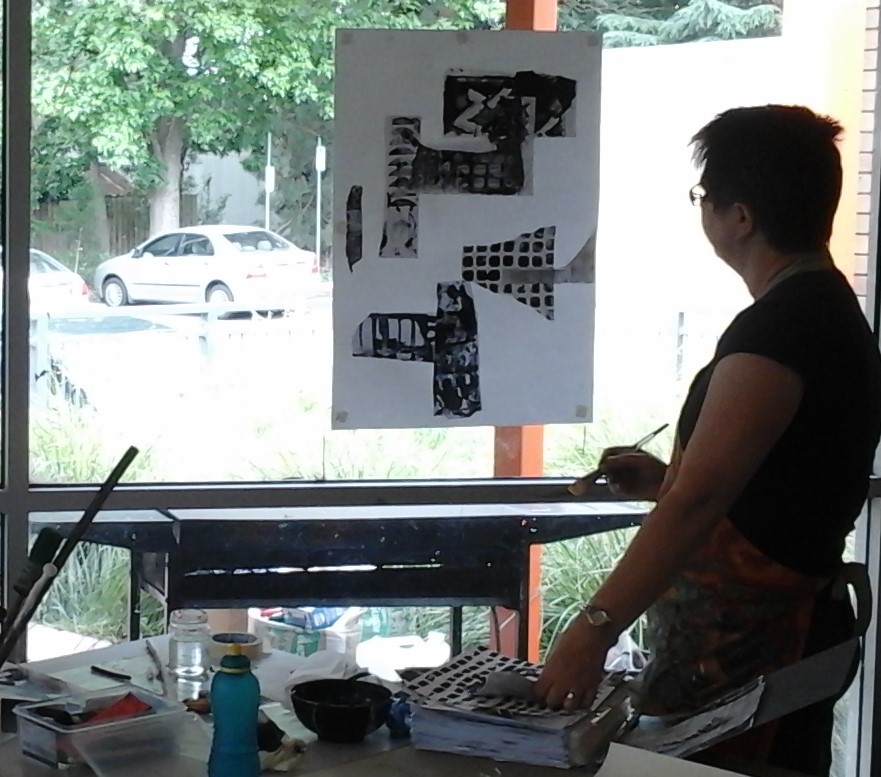What was my ‘want’
in signing up for the Artist’s Journey workshop, a workshop that explores what stops creatives from working creatively and authentically?
The main – was to get into the habit of working in a journal and one of the activities of the workshop was precisely to keep a journal to establish this habit or ritual. Dawna's promotional blurb read 'creating and using a visual journal to inform your work'. Tailor made you'd say.
The main – was to get into the habit of working in a journal and one of the activities of the workshop was precisely to keep a journal to establish this habit or ritual. Dawna's promotional blurb read 'creating and using a visual journal to inform your work'. Tailor made you'd say.
But I know from experience that journaling can become like ‘the work’ as you get immersed in process, as it gains in significance or momentum. One or two other workshop participants describe having shelves of journals and Dawna too certainly would have her own library of journals, as she begins one with each new trip taken or new project. You don't have to fill all the pages, she suggests. I don't want to get too caught up in journaling that it eclipses everything else.
Journals are
source materials for a writer or the visual artist. I have made good use of them. Last year I threw out 15-20 years of hand
written journals because I didn’t want to have to keep them (for the large part
unopened) on my shelves. Someone suggested rather too late that I should have used them for garden compost, an idea which greatly appealed
to me. I have also written quite
extensively about myself (created a couple of unpublishable manuscripts) –
those self-to-self dialogues and approximations to meanings are forever
evolving. I decided to stop the
conversation with myself. There were a
couple of public textile ‘creative syntheses’, namely the Battlecoat and the
Story Cloth in particular, which brought the essences of my conversations
somewhat to a full-stop, though they may actually be a comma or (…) a pause. If truth be told, I had been keeping the
journals because I have problems with memory and realized one day that keeper
of my memory – my mother – won’t always be around to remind me. Sometimes, it’s just healthy to forget… make the
most of the ellipses in the brain…
When I
signed up for the Artist’s Journey workshop back in August I wasn’t exactly experiencing
a creative block, though somewhat down-hearted. I
hadn’t been in the studio most of the winter.
We were undergoing renovations and I had been laid up with flu for
several weeks, and was probably just tired, after the frenzy of the Open
Studios preparations and the actual weekend itself. I collapsed just prior to the weekend with another disk problem. Not much interested me. I now had not one but two herniated disks,
which cause numbness in both my legs.
Clearly some time out was required.
I read, I moped. I did some very
minor assisting with the renovation work, always conscious of my bad back. I
have had moments of not been able to move at all, as well as, being in
excruciating pain and I don’t like those moments. I was also searching to extend my
repertoire so that I could ease up on my back and not have to make big felted
pieces.
I had
purchased a visual journal some 6-8 months before which remained ‘empty’. I
knew I wanted to incorporate drawing – turned into expressive (rather than
pretty) stitching – but how? Buying and
reading a book didn’t motivate, rather it made the task seem too hard to begin
(so there was a block after all!)
I greatly admired Dawna’s use of stitching in her beautifully composed textile work. I noticed that Dawna, who is a hills’ resident and lives not 15 minutes’ drive from me was running a workshop at the Ballarat Fibre Forum next year, but as with most of these workshops, I have the uncanny knack of finding out about them when they are already full. Then fortuitously she came to offer the same workshop (with some modifications – it is not for instance, exclusively for the textile artist) at Burrinja Cultural Centre, only a 10-minute drive away.
I have been attending the workshop 2 days a week for the past 2 weeks and the final two days wrap up this week. In retrospect attending over 4-5-6 intensive days in a row away from home and its many distractions, obligations, and interruptions would have been far more fruitful for me. But you have to work with what you have…and now that the course is about to end I wish there were several more weeks of it ahead.
The afternoons
have been left for ‘playing’. We’ve made
mark making tools (to overcome the resistance if one has it that one can't draw), played with Dawna’s tools, mono-printed on paper and fabric;
and last week we used our bits and pieces of ‘experimentals’ to create a ‘large’
work. This was the most satisfying experience
for me, when I could bring all elements of play and learning into a creative
synthesis.

Dawna's amazing collection of hand-made tools
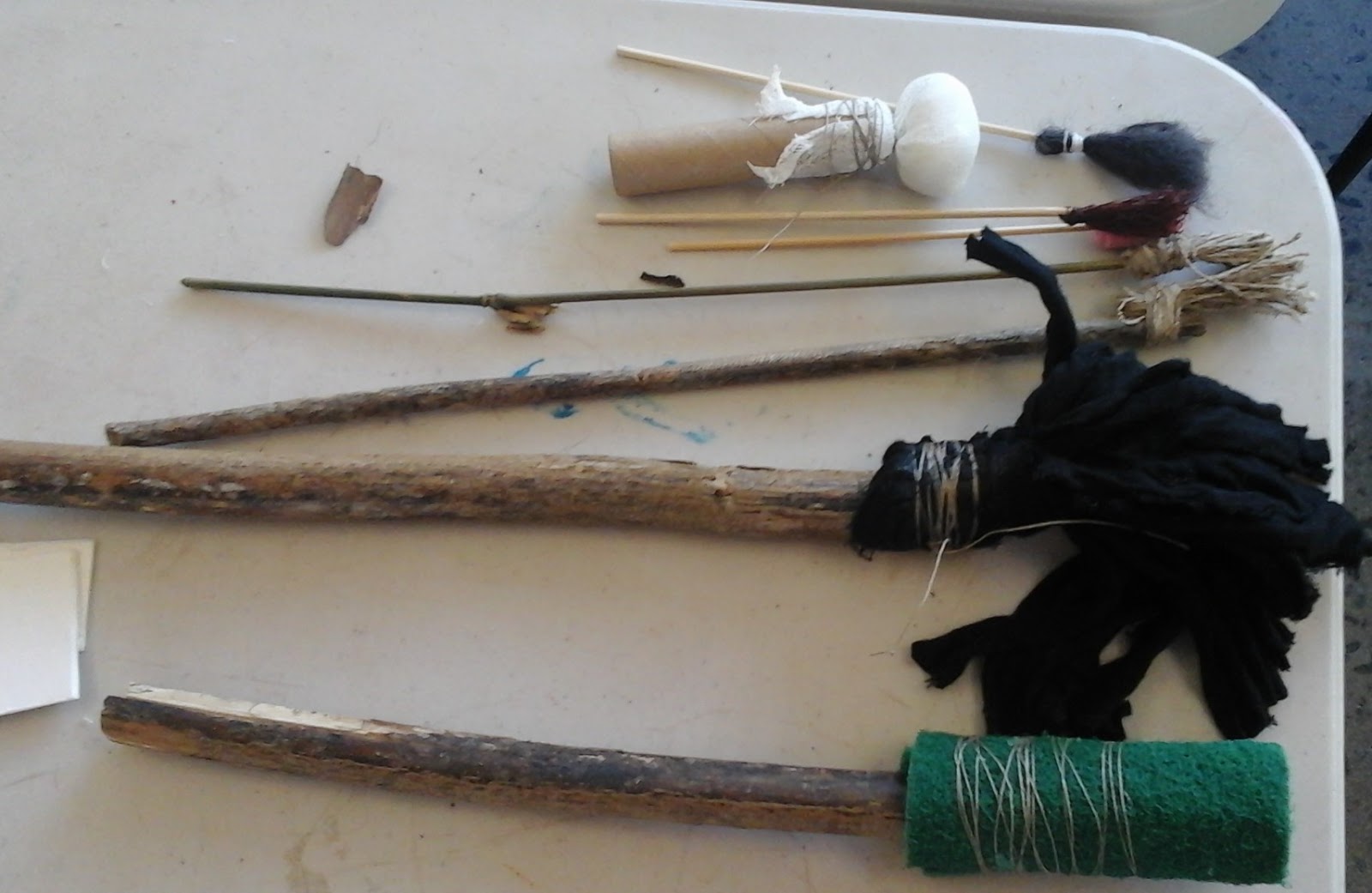
My modest collection which is of 'brush type' tools mainly
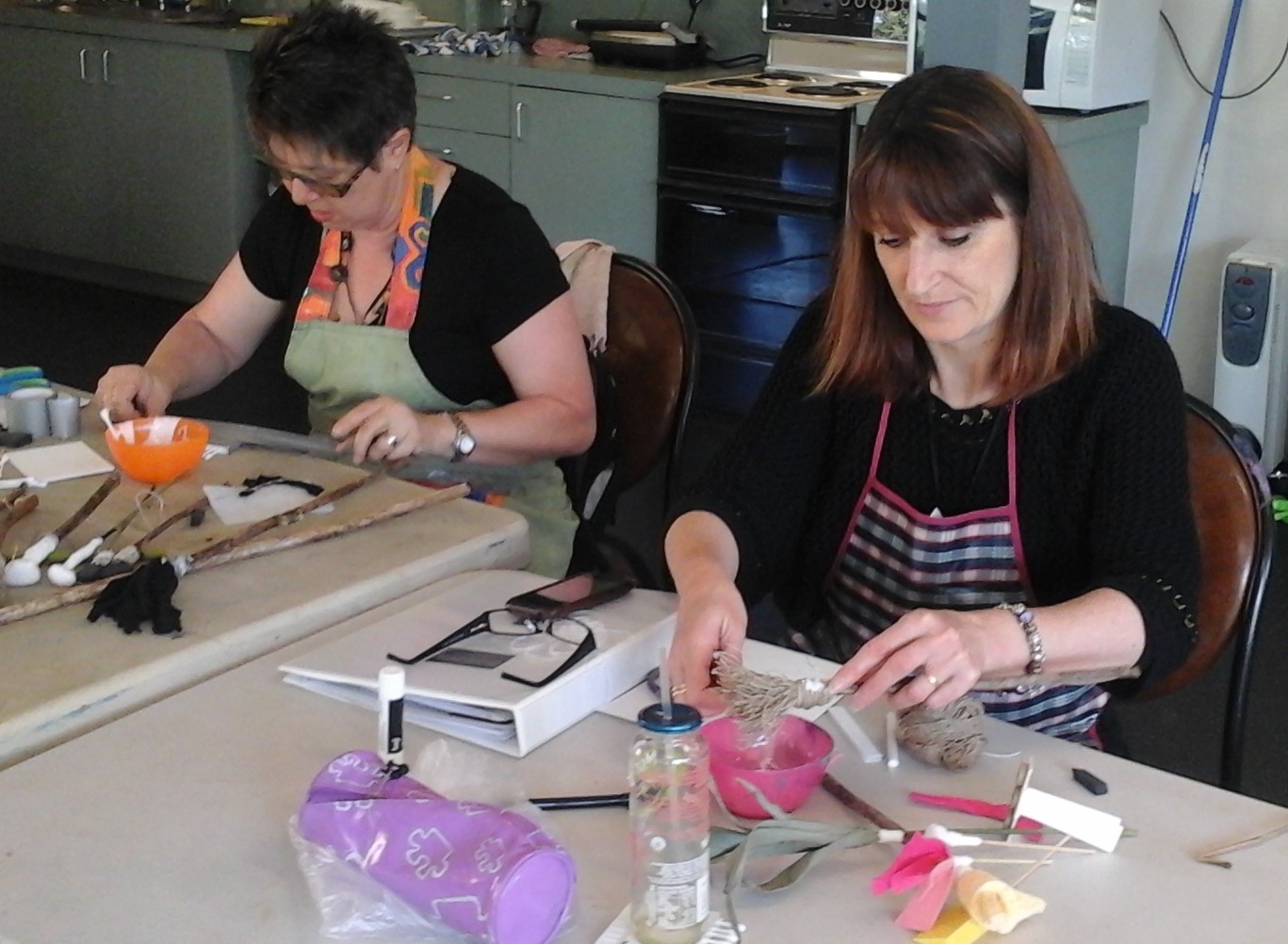
Rhonda and Sheryn focused on the tool making

Max looking excited to begin mark-making

My journal showing photocopies of some of the results of my mark-making

My mono-printing results

A close up of some mono-print beauties
Up until last
week my journal remained mainly ‘empty’. One morning
was given over to participants showing off their workings in their journals and
I had to face not having done anything. My
life is fairly busy (I have been preparing for a Christmas Sale, and Philip and
I run an AirBnB); and Dawna did say no homework (but then she sets homework tasks!). Sheepishly, I had to show what I had not done
and make up an excuse…but look deeply within to see what had prevented me from
working in my journal. I have used
journals and collage to document the explorations of self during my training as
an arts therapist (and maybe I just don’t want to go there again please let me
reiterate) though someone did point out this kind of working in a journal is
entirely different. Indeed, I know this.
When I work,
if it is a major project I will have done some research if needed, preliminary drawing
(really just doodles), writing down ideas (intention), made a pattern or
template (usually after consultation with Philip as he’s great at maths and
blowing a pattern up for me and most of the time he tends to make my templates),
and I would have considered colours, but the work really comes into being when
I start to play with materials in a colour field on my tables. So I tend to allow the work its own impetus –
feeling my way mostly, not knowing where it is I’m going. 'Allow it to be what it wants to be', repeating
the directive of a painting teacher I once knew.
I find that
when I start to do the exercises given for homework I’m treating them too much
like ‘homework’ or an assignment I don’t want to get wrong (mind you the one I did
manage to do, I interpreted the instructions incorrectly). I suppose it’s good to notice these things. I’m
often scared to get it wrong but I can plunge in and see what happens regardless. With a
large piece, for instance The Turncoat,
I had one chance to get it right and if it was wrong, there was no time to make
it right for the DROS exhibition, or indeed make a practice piece. I gambled on the risk of just doing it and getting
it right.
Over the last couple of days I have managed to scribble a few
observations into my journal, choosing to use a large felt tip pen (to fill up
the pages more quickly) but also to allow my writing a large scribbling
presence. Often I write too small. And I
have pasted some photocopies of the results of my ‘playing’… I will pause here, as I’ve gone on too long
really…
Enjoy the
photos…the workshop is a great buzz and I would encourage anyone who is
thinking of taking it to do so, whatever be your reasons. Dawna Richardson-Hyde
thoroughly enjoys teaching and her methodology and presentation do her great
credit. She offers a deep well of knowledge and inspiration. For more about Dawna you can view her website www.makeart.com.au.

All busy...my Untitled No 2 in the background

my Untitled No 3, made by marks, layers and collage
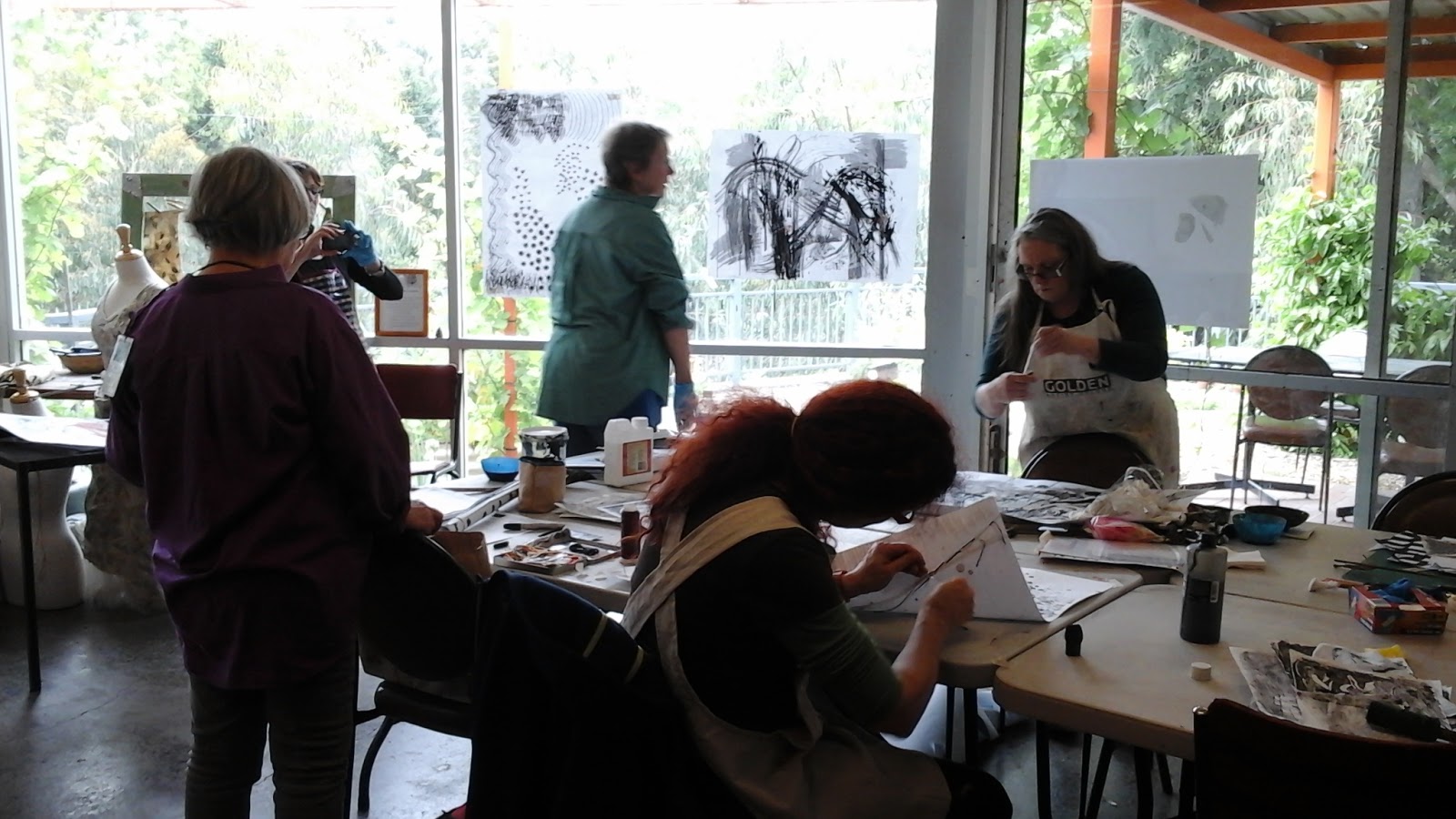
Untitled No 2 in a different phase background.
Foreground Max is adding stitch
Foreground Max is adding stitch

Untitled No 2 'finished' I think (but I could keep adding layers).
This wasn't supposed to be 'the work' but it could be
This wasn't supposed to be 'the work' but it could be

Untitled No 1 starting with rubbings made while on the floor (the brief was to work on the floor)
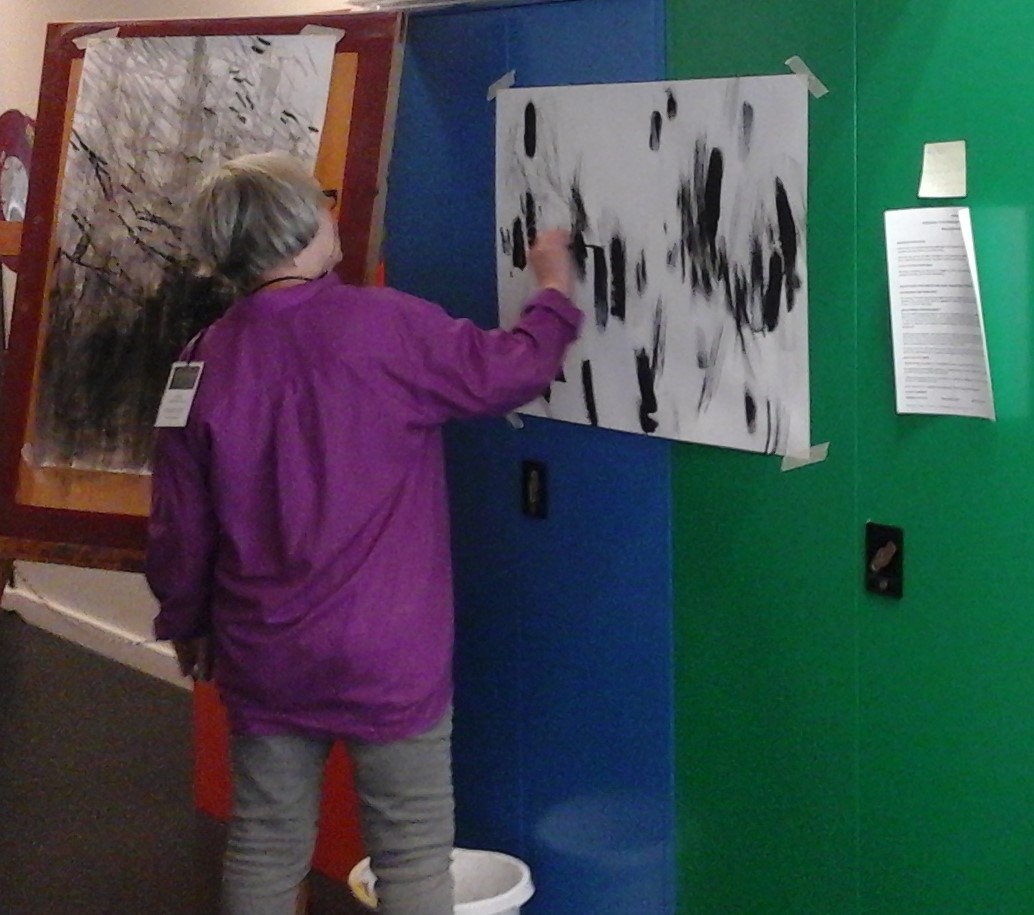
Dawna giving herself permission to play alongside us

Christina's piece focuses around a large 'A'

Sandy chose to work outside
The next three photos show Rhonda working according to the directive we were given, make a mark, step back, look, make another mark, look again
